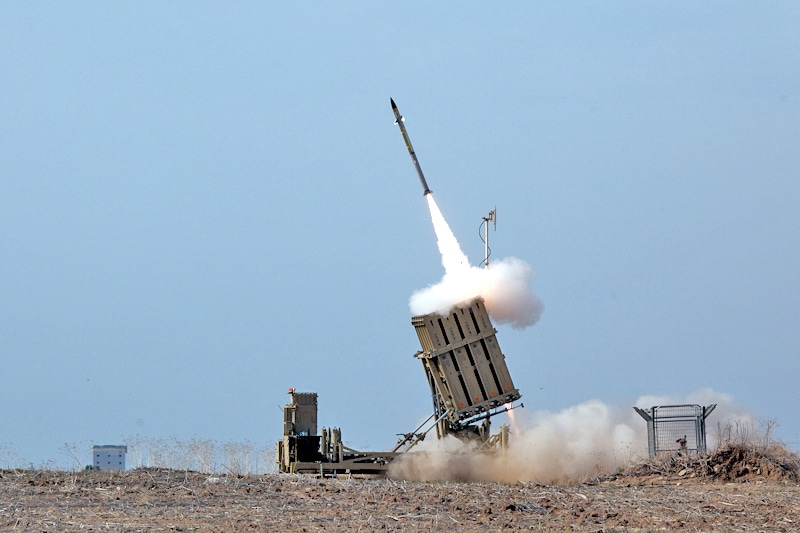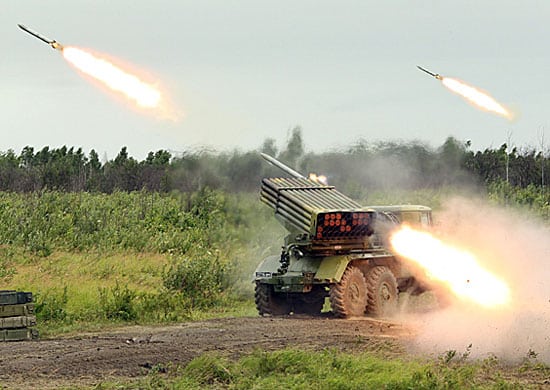Stavros Atlamazoglou

The Iron Dome is an air-defense system designed to intercept rockets and artillery shells with ranges of up to 44 miles. Developed by Rafael Advanced Defense Systems and Elta Systems, the Iron Dome is comprised of a battery, radar, and a command and control system. Each battery has three launchers that carry 20 interceptor missiles each for a total of 60 missiles per battery.
What makes Iron Dome so useful is its technical capability to track the trajectory of each incoming rocket or artillery shell and determine if it is heading towards an urban area. Only if the incoming munition is going to strike a city or village will the Iron Dome attempt to intercept it.
 Iron Dome launcher (WikiMedia Commons)
Iron Dome launcher (WikiMedia Commons)According to the Israeli Defence Force, Iron Dome had shot down 85-90% of incoming rockets that were projected to land within populated areas by Wednesday of this week.
Here is some video footage from the ongoing engagements in the skies over Israel that show the Iron Dome in action. It is definitely an interesting sight as Iron Dome interceptor missiles destroy several rockets fired by Hamas in midair.
Downsides to the Iron Dome
But the Iron Dome does have its downsides.
The air-defense system is expensive, with each interceptor missile costing between $40,000 to $50,000. Hamas, on the other hand, spends approximately $800 to a few thousand dollars for each rocket it launches against Israel.
Thus, the Iron Dome system might be very effective in terms of interception rates, but it is financially inefficient compared to the threat. Of course, it’s hard to put a price tag on the psychological benefits of your population knowing that there is an unseen umbrella that can protect you quite effectively from rocket or artillery attack. Additionally, there is an undetermined financial benefit of preventing munitions from disrupting normal life.

Does the United States also use the Iron Dome?
The Iron Dome makes sense for a country like Israel, which is bordered by real threats that can reach deep into the country and target the civilian population, but it doesn’t make that much sense for a country, like the U.S., that isn’t surrounded by adversaries.
The Iron Dome system’s utility to U.S. bases overseas also may not be great in this era of renewed near-peer conflicts. Nations such as China and Russia are vastly more advanced than organizations like Hamas and Hezbollah, both of which are designated as terrorist organizations by the United States.
For example, while Hamas is lobbing a few dozens or even a hundred rocket against Israel at a time, a Russian artillery battalion using the simple BM-21 truck-mounted rocket launcher can launch up to 720 rocket in 20 seconds—there is a reason why the German infantry was so afraid of the Soviet Katyusha rocket launcher during the Second World War.
 Russian BM-21 (Courtesy of the Kremlin)
Russian BM-21 (Courtesy of the Kremlin)Similarly, two or three North Korean ICBMs fired at the same target can achieve better results than hundreds of small-yield rockets.
However, the US military has decided to purchase the Iron Dome system for installation protection, presumably in the Middle East, where the threat from Iran, which employs similar tactics as Hamas and Hezbollah, is great.
In comparison, the US military has opted for a layered, forward-deployment missile defense that incorporates not only several services but also at times other countries, such as South Korea and Japan.
Some of the air defense systems that the US military employs for missile defense are the Terminal High Altitude Area Defense (THAAD), which is designed to intercept short and medium-range ballistic missiles, the MIM-104 Patriot, which is designed for short to medium interceptions, and the AEGIS, which is primarily deployed on Navy destroyers but can also be placed ashore, but with questionable effectiveness.
No comments:
Post a Comment